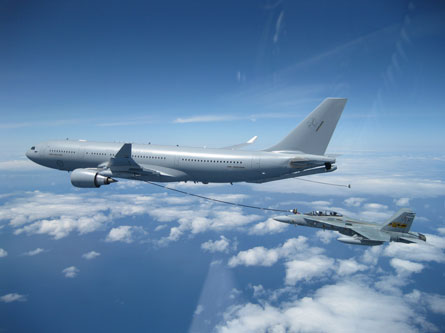The Royal Australian Air Force gave an international debut to one of its Airbus Military KC-30A (A330) multi-role tanker/transports (MRTT) at the Langkawi International Maritime & Aerospace exhibition in Malaysia. The aircraft flew an RAAF contingent to the show and appeared on static display.
In a presentation to journalists, the RAAF said it is currently testing the aircraft's Cobham 905E hose and drogue refuelling system with the Boeing F/A-18F Super Hornet.
"We're exploring the aircraft's wake turbulence envelope and preparing for certification," said Lt Col David Strong from the RAAF's 33 Sqn.
"The drums are electrically - not hydraulically - operated," Strong added. "When a fighter plugs into it there is less chance of a wave going up the hose and then coming back and ripping the probe off. Regardless of a fighter's closure, a wave won't go up the hose and come back."
 |
|---|
| ©Commonwealth of Australia |
He added that the underwing hoses can transfer 1,225kg (2,700lb) of fuel per minute at 50 pounds per square inch, and the boom 3,630kg.
Using the hose and drogue it takes 6min for a Super Hornet to on-load 3,175kg of fuel. While the boom's flow rate is higher, it is not useful for refuelling fighters owing to the limited amount of fuel smaller aircraft can take on board per minute.
Strong added that the hose and drogue is twice as efficient as the boom because two fighters can refuel simultaneously. The RAAF is yet to start testing the boom.
Strong said in-flight refuelling is vital for the RAAF, particularly when it participates in exercises or operations overseas. "It's particularly important for us because we are so remote," he said. "We need to get our forces up into southeast Asia and work with our allies in a timely, responsive manner."
He noted the vast distances involved in Australia, and that Langkawi is a 9h flight from the KC-30A's home base in Amberley, Queensland.
The RAAF foresees its new tankers facilitating tasks such as defensive counter-air and strike missions. When the boom is available it will be able to refuel the service's Boeing C-17 strategic transports and Boeing 737-based Wedgetail airborne early warning and control system aircraft, as well as other KC-30As.
Australia will also use the aircraft as a transport. It can carry 270 passengers on its main deck as well as 40 tonnes of cargo in its under-floor hold. The RAAF said the passenger cabin is virtually identical to that found on Qantas A330s.
Three of the air force's eventual five KC-30As have been accepted so far, with the remainder to be handed over by mid-2012.
Separately, Airbus Military chief executive Domingo Urena said there could be a strong market for the A330 MRTT in southeast Asia, owing to the great distances in the region and the aircraft's ability to perform as both in-flight refuelling tanker and passenger aircraft.
He said Indonesia, Malaysia and Singapore could all be viable markets for the type, although no discussions have been held as yet.
Source: Flight International
















